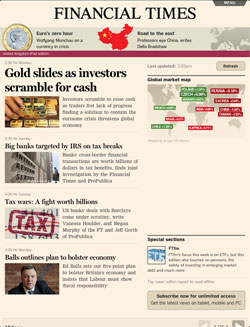FT HTML5 app boosts readership levels
Readers consuming more content with web app than on the desktop

Over the summer, .net reported on the FT's HTML5 app for iOS. Steve Pinches, FT group product manager, emerging platforms, told us that HTML5 brought the FT advantages, including delivering a "traditional app like experience in a web browser that is faster and features new content such as video and FT blogs", not having to wait for updates to be approved, and the single code-base being more efficient. He believed "web apps will become the way of the future".
Earlier this month, FT's native app was pulled from the App Store, due to no longer complying with Apple's demands for a 30 per cent cut of subscription revenues, and also because Apple would not supply access to subscriber data. The move was undoubtedly a risk, but Pinches may well be proved to be right. According to a report by Reuters, the FT claims the new HTML5 app has drawn more traffic that the old native version. FT.com Managing Director Rob Grimshaw is quoted as saying readers are spending more time with the app and consuming more content than they do through the desktop.
In the latest Monday Note, Frdric Filloux also questions the future of encapsulated digital editions (be they app or "PDF-shovel editions"). He suggests most are unsatisfactory, but BloombergBusinessweek+ demonstrates that with great care, in terms of graphics, structure, content and pricing, this needn't always be the case.
BloombergBusinessweek+ shows that "an encapsulated digital edition of a magazine can fly," Filloux says, "even though patience and deep pockets are required". Still, with much of the publishing sector in decline, deep pockets are few and far between, and so it's probable more companies will follow in the footsteps of the FT, opening up further opportunities for web designers and developers.
Daily design news, reviews, how-tos and more, as picked by the editors.

The Creative Bloq team is made up of a group of art and design enthusiasts, and has changed and evolved since Creative Bloq began back in 2012. The current website team consists of eight full-time members of staff: Editor Georgia Coggan, Deputy Editor Rosie Hilder, Ecommerce Editor Beren Neale, Senior News Editor Daniel Piper, Editor, Digital Art and 3D Ian Dean, Tech Reviews Editor Erlingur Einarsson, Ecommerce Writer Beth Nicholls and Staff Writer Natalie Fear, as well as a roster of freelancers from around the world. The ImagineFX magazine team also pitch in, ensuring that content from leading digital art publication ImagineFX is represented on Creative Bloq.
